RAF Advanced Air Striking Force
| RAF Advanced Air Striking Force | |
|---|---|
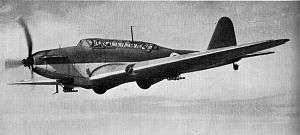 A Fairey Battle light bomber | |
| Active | 24 August 1939 – 26 June 1940 |
| Country | United Kingdom |
| Type | Bomber |
| Engagements | Battle of France |
| Commanders | |
| Notable commanders | Air Vice-Marshal Patrick Playfair |
| Aircraft flown | |
| Bomber |
Fairey Battle Bristol Blenheim |
| Fighter | Hawker Hurricane |
The RAF Advanced Air Striking Force (AASF, Air Vice-Marshal Patrick Playfair) was formed on 24 August 1939 from 1 Group Royal Air Force (RAF) and its ten squadrons of Fairey Battles were dispatched to airfields in the Rheims area on 2 September 1939. Before the Second World War it had been agreed between the United Kingdom and France that in case of war, the light bomber force of RAF Bomber Command would move to French airfields to operate against targets in Nazi Germany.
The AASF was independent of the British Expeditionary Force and answerable to the Air Ministry. For greater unity of command, the AASF and the Air Component of the BEF (Air Vice-Marshal Charles Blount) came under the command of the British Air Forces in France (Air Vice-Marshal Arthur Barratt) on 15 January 1940. Using the bombers for attacks on strategic targets in Germany was set aside, due to French objections; attacks on German military forces and their communications was substituted.
In the afternoon of 10 May 1940, the beginning of the Battle of France, 32 Battles attacked German columns in Luxembourg and 13 were lost; ten Battles of 32 were lost in a second raid. During the night, Bomber Command aircraft based in England, attacked transport bottlenecks in the southern Netherlands.
Background
Anglo-French air policy
Once British rearmament began, the air policy of the British government was to have air defences sufficient to defeat an attack and an offensive force equal to that of the Luftwaffe. With no land border to defend, British resources had been concentrated on radar stations, anti-aircraft guns and increasing numbers of the most modern fighter aircraft. If Germany attacked, the British intended to take the war to the Germans by attacking strategically-important targets with its heavy bombers, types unsuitable for operations in direct support of land forces.[1] Implementation of the policy required a considerable number of first-class fighter aircraft to defeat an attacker and bombers to destroy ground targets. In 1938 the RAF expansion programme was intended to provide means for the air defence of Britain and for counter-offensive operations against Germany. Army co-operation received scant resources and no plans were made for RAF participation in mass land operations or the dispatch abroad of of large expeditionary air forces. The Western Plan had been devised by the Air Ministry for mobilisation and the deployment of squadrons to their wartime airfields. Provision was made for the immediate dispatch of an Advanced Air Striking Force of ten squadrons to France, followed by ten more. Refuelling facilities were also planned for other squadrons, the arrangements for transport and servicing being co-ordinated with the army; thought was also given to basing squadrons in Belgium if it was invaded by Germany.[2]
In February 1939, the British Cabinet had authorised joint planning with the French and preferably Belgium and the Netherlands in case of war with Germany, Italy and Japan. Two weeks before the first meeting Germany occupied the rump of Czechoslovakia and war preparations took on a new urgency and staff conversations began on 29 March 1939.[3] Agreement was reached with France to base the AASF on French airfields but only to bring them closer to their intended targets in Germany, until longer-range types became available.[4] French strategy emphasised the defence of the national territory and Allied efforts were expected to give equal emphasis. The British refused to stake everything on the success of a defensive campaign against the Germans in France. The different circumstances of the two countries led the French to rely on a mass land army with air defence a secondary concern and the Armeé de l'Air was hampered in the late 1930s by the slow progress if its re-equipment, lacking the means to detect and track enemy aircraft, anti-aircraft guns and fighter aircraft. Observation services relied on civilian telephones and in October 1939, the Armeé de l'Air had only 549 fighters, 131 of which were considered anciens. Lack of aircraft led the French to advocate a bombing policy of tactical co-operation with the armies, to attack German forces and communications in the front line, rather than the strategic bombing of Germany, for fear of retaliation.[1]
From the spring of 1939, arrangements were made for the reception of the AASF, the defence of British bases in France, bombing policy in support of ground forces confronting a German attack in the Benelux countries and for operations against the Luftwaffe. A supply of British bombs was dumped near Reims, disguised as a sale to the Armée de l'Air. Discussion of strategic air operations against the German war economy because the British did not expect to begin such operations as soon as war was declared and because the French had no bombers capable of such operations. In the last days of peace, the Cabinet limited air bombardment strictly to military objectives, narrowly defined and a joint declaration was issued concerning this policy, following of the rules of war pertaining to poison gas, submarine warfare and air attacks on merchant ships, to avoid provocation while the Anglo-French air forces were being built up.[5]
24 August 1939 – January 1940
_in_France_1939-1940_C76.jpg)
On 24 August 1939, the British government gave orders partially to mobilise and No. 1 Group RAF (Air Vice-Marshal Patrick Playfair) sent its ten Fairey Battle day-bomber squadrons to France on 2 September, according to plans established by the British and French earlier in the year. The group was the first echelon of the AASF and flew from bases at Abingdon, Harwell, Benson, Boscombe Down and Bicester. Group Headquarters became the AASF when the order to move to France was received and the home station HQs became 71, 72 74–76 Wings. The Bristol Blenheims of No. 2 Group RAF were to become the second echelon as 70, 79, 81–83 Wings, flying from Upper Heyford, Watton, West Raynham, Wyton and Wattisham; 70 Wing with 18 and 57 squadrons, was changing from Battles to Blenheims, being intended for the Air Component.[6] On 3 September, when the British government declared war on Germany, the AASF Battle squadrons were getting used to their French airfields, somewhat rudimentary compared to their well-developed Bomber Command stations, some squadrons having to wait for the French to deliver fuel fuel.[7]
Long-range reconnaissance of Germany, north of a line Düsseldorf, Paderborn and Lübeck, was an RAF responsibility. A Blenheim of 139 Squadron from Wyton, flew the first RAF wartime reconnaissance sortie over Germany, photographing airfields and ships in Wilhelmshaven. Tactical reconnaissance sorties by AASF Battles began on the morning of 9 September, when three Battles of 226 Squadron flew to Thionville. On 10 September, three Battles of 150 Squadron scouted the Franco-German border, followed by three from 103 Squadron and three from 218 Squadron on 17 September; a two-day lull caused by bad weather ensued. The Battles encountered nothing worse than intermittent anti-aircraft fire (Flak) but on 20 September, three from 88 Squadron were attacked over Aachen by Luftwaffe Messerschmitt Bf 109 fighters and lost two aircraft, for one Bf 109 claimed shot down. At 3:00 p.m. on 30 September, five Battles of 150 Squadron en route to Saarbrücken, were bounced (attacked by surprise) by eight Bf 109s and lost four aircraft in a few minutes, after which, the Battles stopped flying daylight sorties.[8]

The exposure of the AASF Battles as death traps when confronted by effective fighter opposition, led to plans for strategic bombing of German industrial targets being set aside in favour of tactical bombing, at low altitude, of transport bottlenecks along all of the Western Front, with the AASF fighters to escort the bombers and defend the area around Reims. The seven Blenheim squadrons of 2 Group in England were given the same role under BAFF operational control with the two Whitley squadrons of 4 Group, for the night bombing of German communications further back.[10] With a maximum speed of 241 mph (388 km/h) the Battles would be sitting ducks to ground anti-aircraft fire of the accuracy and intensity possessed by the German army.[11][12] In April 1940, the RAF tried to improve its aircraft, streamlining the Blenheim added 15 mph (24 km/h) to its speed, more defensive armament, armour and self-sealing fuel tanks were added to aircraft. To remedy the vulnerability of Battles to attacks from below, Fairey designed a gun position,
To enable the gunner to fire backwards behind the tail, the gun swivels on a mounting fixed in the bombing aperture and is made capable of firing upside down, being provided with extra sights which will work in this position. The gunner wears a special harness enabling him to assume an almost upside-down position.
— Bomber Command Headquarters Record Book[13]
which was not much used.[13] The Battle squadrons spent the autumn and winter on training and army co-operation sorties, making spoof attacks on BEF transport around Arras, flying night, cross-country sorties over northern France and practice bombing sorties.[14] Air fighting continued as both sides learned that fighters were necessary to protect reconnaissance machines and also to deprive opposing aircraft of free access to their airspace.[15]
On 11 October, Luftwaffe Dornier Do 17 bombers begin to cross the lies at high altitude and one flew at 20,000 ft (6,100 m) over the 1 Squadron AASF fighter base at Vassincourt, only to be shot down near Vausigny. The two Hawker Hurricane fighter squadrons (67 Wing) were part of the AASF ro provide fighter protection, with another squadron of Hurricanes available as a reinforcement; 15 and 40 squadrons were sent back to Britain in December to convert to Blenheims and were replaced by 114 and 139 squadrons.[15] The second echelon squadrons of 2 Group, with seven Blenheim squadrons and two Whitley squadrons stood ready to move to France if the Germans attacked. At 10:00 a.m., on 8 November, 73 Squadron shot down a Do 17, its first victory of the war. To counter the high-flying Dorniers, seven fighter sectors were established on 21 November in Zone d'Opérations Aériennes Nord (Z.O.A.N.) and Zone d'Opérations Aériennes Est (Z.O.A.E.) and on 22 November, 1 Squadron shot down two Do 17s in the morning, a Hurricane force-landing after being hit in the engine and early in the afternoon, three Hurricanes over Metz, shared a Heinkel He 111 with the Armée de l'Air, one Hurricane being damaged by collision with a French fighter; 73 Squadron claimed two Dorniers shot down and one damaged, shared with French fighters. For most of December, flying was washed out by bad weather but on 21 December, two Hurricanes shot down a Potez 637 over Villers-sur-Meuse, with only one survivor. The next day, three 73 Squadron Hurricanes were bounced by five Bf 109s, which shot down two of the British aircraft.[16]
Prelude
January–April 1940
British Air Forces in France
| Aircraft | Squadron |
|---|---|
| In France | (first echelon) |
| Battle | 12, 15, 40 88, 103, 105 142, 150, 218, 226 |
| Blenheim IV | 114, 139 (from December 1939) |
| Hurricane[lower-alpha 2] | 1, 73 (501 from 11 May 1940) |
| In England[lower-alpha 3] 2 Group | (second echelon) |
| Blenheim IV | 21, 82, 107, 110 |
| 4 Group | |
| Whitley | 77, 102 |
| Losses[20] | |
| AASF | Battle:.....137 Blenheim: 37; Total: 174 |
| 2 Group | Blenheim:....................98 |
| Total losses | 272 |
On the declaration of war, the Air Component had come under the command of Lord Gort the Commander-in-Chief of the BEF and the AASF remained under Bomber Command control but with the Armée de l'Air this made three air forces. Thought had been given to liaison and Air Missions had been installed in the main Allied headquarters but training exercises showed that communication was inadequate. In January 1940, command of the AASF and the Air Component was unified under Air Marshal Arthur Barratt as Air Officer Commanding-in-Chief British Air Forces in France (BAFF), the Air Component being detached from the BEF while remaining under its operational control and Bomber Command losing command of the AASF.[21][lower-alpha 4] Barratt was charged with giving "full assurance" to the BEF of air support and to provide the BEF with
...such bomber squadrons as the latter may, in consultation with him, consider necessary from time to time.
Since the British held only a small part of the Western Front Barratt should also operate in the context of the immediate needs of the Allies. In France the new arrangement worked well but the War Office and the Air Ministry never agreed on what support should be given to the Field Force of the BEF.[23] When Air Marshal Charles Portal replaced Edgar Ludlow-Hewitt as AOC-in-C Bomber Command on 3 April, he prevented the second echelon of the AASF from going to France, with the support of the Chief of the Air Staff Cyril Newall. Portal took the view that fifty Blenheims attempting to attack an advancing army using out of date information, could not achieve results commensurate with the expected losses.[24] On May 8, he wrote,
I am convinced that the proposed employment of these units is fundamentally unsound, and if it is persisted in it is likely to have disastrous consequences on the future of the war in the air.
— Portal[11]
The airfields occupied by the first echelon were still being equipped for active operations and would become dangerously congested if the second echelon arrived. Barratt questioned the wisdom of an assumption that because the AASF was behind the Maginot Line, mobility was less important than in the Air Component and approval was eventually given to make the AASF semi-mobile but this did not occur in time and the AASF had to borrow or commandeer French vehicles when squadrons had to change base; by late April, the AASF had a strength of 6,859 men.[25]
AASF operations
There was more flying in January but the air forces spent most of February on the ground, with many of the aircrews on leave but the March wather was much better and on 2 March a Dornier was shot down by two 1 Squadron Hurricanes, one of the British pilots being killed attempting a forced landing, after being hit in the engine by return fire; next day, British fighters shot down a He 111, On 3 March, two 73 Squadron pilots escorting a Potez 63 at 20,000 ft (6,100 m) spotted seven He 111s 5,000 ft (1,500 m) higher and gave chase, only to be attacked by six Bf 109s, the second of which overshot one of the Hurricanes, was hit and fell, leaving a trail of black smoke, the eleventh victory for the squadron. The Hurricane was hit by the third Bf 109 and the pilot only just managed to reach a French airfield and make an emergency landing. On the morning of 4 March, a 1 Squadron Hurricane shot down a Bf 109 over Germany and later, three other Hurricanes of the squadron attacked nine Messerschmitt Bf 110s north of Metz and shot one down. On 29 March, three Hurricanes of 1 Squadron over Bouzonville were attacked by BF 109 and Bf 110 fighters, a BF 109 being shot down at Apach and a Bf 110 north-west of Bitche, one of the Hurricane pilots being killed trying to land at Brienne-le-Chateau.[26]
Most Luftwaffe incursions in April were the usual reconnaissance flights but larger formations of fighters patrolled the font line and formations of up to three Luftwaffe fighter squadrons flew as far as Nancy and Metz at high altitude. Reconnaissance aircraft began to cross the front line in squadrons, to benefit from greater firepower on the most dangerous part of the journey, before dispersing towards their objectives. Hurricanes shot down a Bf 109 on 7 April at Ham-sous-Varsberg and on 9 April, when the Germans invaded Denmark and Norway in Operation Weserubung, the Battle squadrons took over on night leaflet raids over Germany as Bomber Command aircraft were diverted to operations in Scandinavia; no Battles were lost on these sorties. The situation was unchanged until the night of 9/10 May when the heavy artillery of the German and French armies began to bombard the Maginot and Siegfried lines.[27]
Battle of France
10 May 1940

On 10 May, the AASF had 416 aircraft, 256 of which were light bombers, 110 of the 200 serviceable bombers being Battles.[28] The Armée de l'Air had fewer than a hundred bombers, 75 percent of which were obsolescent.[29] The Luftwaffe forces in the west had 3,530 operational aircraft, including about 1,300 bombers and 380 dive bombers. As dawn broke, the German bombers made a coordinated, hour-long attack on 72 airfields in the Netherlands, Belgium and France, inflicting severe losses on the Belgische Luchtmacht/Force aérienne belge and the Koninklijke Luchtmacht.[30] The Luftwaffe bombers flew in formations of 3 to 30 Heinkel 111, Dornier 17 and Junkers 88 aircraft but had least effect on the British and French airfields, over which the British and French fighters intercepted the German raiders.[31] Nine British-occupied bases were attacked to little effect, the AASF Hurricane squadrons making a maximum effort and 73 Squadron moving back from its forward airfield to one in the AASF area around Reims. From Britain, 501 Squadron transferred to Betheniville France and went into action within the hour, against forty He 111 bombers.[32] A transport aircraft ferrying pilots and ground crews of 501 Squadron crashed on landing; three pilots were killed and six injured.[33]
The AASF bomber squadrons remained on the ground waiting for orders but until noon, French Grand Quartier Général (GQG, French supreme headquarters) withheld permission to attack. Barratt took matters into his hands and ordered the AASF into action against a German column, reported in Luxembourg by a French reconnaissance aircraft, several hours earlier.[32] The French bomber squadrons received orders and counter-orders and some were sent to make low-level demonstrations to reassure French troops and were intercepted by German fighters. Barratt called General Alphonse Georges, commander of the Théâtre d’Opérations du Nord-Est (North-eastern Theatre of Operations) to tell him that the AASF would commence operations but it it took until noon to get the aircraft off the ground. The AASF squadrons had been on stand-by since 6:00 a.m., one flight in each squadron at thirty minutes' readiness and the other at two hours'. Thirty-two Battles from 12, 103, 105, 142, 150, 218 and 226 squadrons flew in four waves of eight aircraft to bomb German columns advancing through Luxembourg with a few Hurricanes overhead.[34]
No German fighters appeared but massed anti-aircraft fire shot down thirteen Battles and damaged most of the rest. In the afternoon, a second raid by thirty-two aircraft flying at 250 ft (76 m) was intercepted by Bf 109s and ten battles were shot down by the fighters and ground fire. No aircraft From Bomber command in England appeared, because the British state was changing government. Barratt requested support from Bomber Command and during the night, 36 Wellington bombers attacked Waalhaven and eight Whitleys from 77 and 102 squadrons bombed transport bottlenecks into the southern Netherlands at Geldern, Goch, Aldekirk, Rees and Wesel. No raids took place east of the Rhine.[34]
11 May
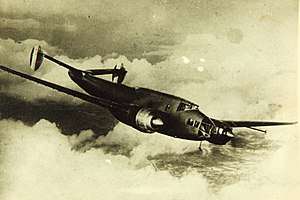
The crews of 114 Squadron at Vraux were preparing to take off in their Blenheims to attack German tank columns in the Ardennes, when when nine Dornier 17s appeared at tree-top height and bombed the British aircraft, destroying them and causing several casualties. During the afternoon, eight Battles from 88 and 218 squadrons flew against German troop concentrations in Luxembourg but were intercepted by fighters en route and all but one were shot down.[35] The Belgian government appealed to the Allies to destroy the Albert Canal bridges around Maastricht but the Germans had installed quickly, masses of anti-aircraft guns. Six Belgian Battles from Aeltre out of nine were shot down around noon and the three remaining caused no damage to the bridges. Six Blenheims from 21 Squadron and six from 110 Squadron in Britain attacked next from 3,000 ft (914 m). As the bombers approached they met massed anti-aircraft fire and broke formation to attack from different directions, only to spot Bf 109s and form up again. Four Blenheims were shot down, the rest were damaged and no bomb hit the target.[36]
Ten modern French LeO 451s from GB I/12 and II/12, escorted by M.S. 406 fighters, attempted the first French bombing of the war and caused fires among German vehicles but failed to hit the bridges. The Morane pilots attacked the German fighters and claimed five Bf 109s for four Moranes; one LeO 451 was shot down and the rest o bacly damaged that they would not be operational for several days. During the night of 11/12 May, Barratt called on bomber Command again to attack transport targets around München-Gladbach; Whitleys from 51, 58, 77 and 102 squadrons, with Hampdens from 44, 49, 50, 61 and 144 squadrons provided 36 bombers but five Hampdens returned early and only half the remainder claimed to have bombed the target. A Whitley and two Hampdens were shot down, the Hampden crews, minus one pilot, making their way back to Allied lines.[37]
12 May

At 7:00 a.m., nine Blenheims of 139 Squadron flew from Plivot to attack a German column near Tongeren but were intercepted by fifty Bf 109s and lost seven aircraft, two of the crews returning on foot to Plivot after crash-landing. At Amifontaine, 12 Squadron was briefed for an attack on the bridges near Maastricht by six Battles. The commander asked for volunteers and every pilot did; the six crews on standby were chosen. Three Battles of B Flight were to attack the bridge at Veldwezelt and three from A Flight the bridge at Vroenhoven. Take-off began with A Flight at 8:00 a.m. and the Battles climbed to 7,000 ft (2,100 m); 15 mi (24 km) short of Maastricht, the aircraft received anti-aircraft fire, surprising the crews with the extent of the German advance. Three Hurricane squadrons were to clear the way for the Battles and eight from 1 Squadron, based at Vassincourt, flew five minutes ahead. The Hurricane pilots saw about 120 German fighters above them and attacked; three Bf 109s and six Hurricanes were shot down.[38]
During the diversion, the Battles of A Flight dived over the Maastricht−Tongeren road towards the Vroenhoven bridge; a Bf 109 closed on the leading aircraft, then veered off towards the second Battle, which hid in a cloud. The first Battle bombed when lower than 100 ft (30 m), was hit and came down in a field, the crew being captured.[38] The second Battle crew, having shaken off the Bf 109, saw bombs from the first Battle explode on the bridge and attacked from 2,000 ft (610 m) but hit the water and the side of the canal. The pilot turned away through a web of tracer from the ground and was hit by a Bf 109 before the rear gunner damaged the German fighter. The port fuel tank caught fire and the pilot ordered the other two crew to parachute, then noticed that the fire had gone out. The pilot nursed the bomber home but ran out of fuel a few miles short and landed in a field; the observer got back to Amifontaine but the gunner was taken prisoner. Five minutes later, B Flight attacked the bridge at Veldwezelt, having flown over Belgium in line astern at 50 ft (15 m).[39]

One Battle was shot down before the target and crashed near the canal; the pilot, despite severe burns, saved the crew who were taken prisoner. A second Battle was hit, zoomed while on fire, dived into the ground and exploded, killing the crew. The third Battle made a steep turn near the bridge then dived into it, destroying the west end. German engineers began immediately to building a pontoon bridge and as they worked, 24 Blenheims from 2 Group in England, attacked the bridges at Maastricht; ten were shot down. At 1:00 p.m. 18 Breguet 693s from GA 18 with Morane 406 fighter escorts, attacked German tank columns in the area of Hasselt, St Trond, Liège and Maastricht, loing eight bombers; twelve LeO 451s attacked columns around Tongeren, St Trond and Waremme at 6:30 p.m. and survived, despite most being damaged. Late in the afternoon, fifteen Battles flew against German troops near Bouillon and six were shot down. During the night, forty Blenheims of 2 Group flew in relays against the Maastricht bridges with few losses.[40] By the end of the day, the AASF had been reduced to 72 serviceable bombers.[41]
13–14 May
To conserve the remaining bombers only one AASF attack was made on 13 May, by several Battles of 226 Squadron. The Battles bombed a factory to block a a road near Breda, to support the French Seventh Army as it retreated to Antwerp. French bombers made two attacks during the day and overnight the French bombed German rear areas as the Blenheims of 2 Group attacked the Maastricht bridges and railways at Aachen and Eindhoven. During the night the commander of Groupe d'armées 1, told Barratt that "victory or defeat hinges on the destruction of those bridges".[42] At 4:30 and 6:30 a.m., flights of five Battles from 103 and 150 squadrons attacked the pontoon bridges over the Meuse at Gaulier, to the north of Sedan; all of the Battles returned and some of the pontoons may have been damaged. The appearance of the Germans on the Meuse and the crossings at Sedan, Monthermé and Dinant, surprised the Second Army which needed at least 24 hours to organise a counter-attack; GQG requested a maximum effort from the AASF and the French bomber force. At 9:00 a.m. eight Breguets 693s with Fifteen Hurricane and fifteen Bloch 152 fighter escorts, attacked German tanks at Bazeilles and the pontoons between Douzy and Vrigne-sur-Meuse against scattered anti-aircraft and fighter opposition and all the Breguets returned. At 12:45 p.m., thirteen Amiot143 night bombers were ordered to attack, escorted by thirty French fighters. The Amiots bombed targets around Sedan, Bazeilles and Givonne, losing two to fighters and two to anti-aircraft fire. Eight LeO 451s without escorts attacked south of Sedan and against German tank columns between Bazeilles and Sedan, one LeO being destroyed.[43]
Every serviceable French bomber had flown; since 10 May the Armeé de l'Air had lost 135 fighters, 21 bombers and 76 other aircraft.[43] Playfair had held back the AASF to get as many bombers airworthy as possible; 62 battles and eight Blenheims were made available for operations. The AASF bombers flew from 3–4:00 p.m. Four of five aircraft of 12 Squadron were lost, four of eight from 142 Squadron, three from six of 226 Squadron, six of eleven from from 105 Squadron, four of four from 150 Squadron, one of ten from 88 Squadron, three of eight from 103 Squadron and ten of eleven aircraft from 218 Squadron. Of the eight Blenheims of 114 and 139 Squadrons, with crews from 114 Squadron, five were lost. Two pontoon bridges were destroyed and two damaged in the most costly operation of its size in the history of the RAF. Six Battle crews returned on foot through German-held territory and 102 men had been killed or captured. As night fell, 28 Blenheims of 2 Group attacked the bridges and seven were shot down, two coming down behind Allied lines. The AASF bombers were no longer an effective military force and over 200 Hurricane fighters had been lost in four days. In Britain, Air Marshal Hugh Dowding, the Air Officer Commanding RAF Fighter Command was heard by the War Cabinet. Having already been ordered to send another 32 Hurricanes to France, Dowding urged that French requests for another ten fighter squadrons be refused.[44]
The Blenheims of 2 Group had been attacking railways, bridges and German army rear areas at night and Whitley and Hampden bombers had flown a raid on the night of 11/12 May. The heavy bombers of Bomber Command had made 27 attacks on German communications, supply dumps and oil tanks to impede the advance of the German army but this had not been methodical in the manner of the attacks by Luftwaffe bombers. After the German bombing of Rotterdam on 14 May, Bomber Command was ordered on 15 May, to attack the German war economy beyond the Rhine. During the night, 99 Wellington, Whitley and Hampden bombers attacked oil, steel and rail targets in the Rhineland, inflicting damage on rail junctions and marshalling yards at Aachen, Roermond, Bocholt, Wesel, Mönchen-Gladbach and Cologne, the Autobahn near Duisburg and airfields at Duisburg and Eindhoven.[45]
15 May
After the AASF losses from 10 to 14 May, attacks on the Meuse bridgeheads on 15 may were made by the Bomber Command squadrons based in England. German mobile forces broke out of the bridgehead at Sedan at 11:00 a.m. twelve Blenheims from 2 Group attacked German columns around Dinant as 150 French fighters patrolled in relays. The RAF sent another sixteen Blenheims escorted by 27 French fighters at 3:00 p.m. to attack bridges near Samoy and German tanks at Monthermé and Mezières, from which four Blenheims were lost; a few Battles flew a sortie to Sedan after dark. By the end of the day, BAFF has lost 86 Battles, 39 Blenheims, nine Lysander army co-operation aircraft and 71 Hurricanes; Bomber Command had lost 43 aircraft, mainly from 2 Group.[46]
16–21 May
During the Phoney War the army and the RAF had built many airfields and several grass airstrips were ready around Troyes in southern Champagne. The AASF had been deemed a static unit, well-protected by the Maginot Line and was 600 lorries short of even its slender establishment of vehicles. The AASF was fortunate that the Germans did not try to cross the Aisne and there was time to shift most of the equipment of the AASF, using 300 new lorries from the US, borrowed from the French, at the behest of the Air Attaché in Paris.[47][lower-alpha 5] The AASF distributed the remaining four aircraft and the crews of 105 and 218 squadrons to the other Battle units. The nine surviving Blenheims of 114 and 139 squadrons were transferred to the Air Component, reducing the AASF to six Battle and three Hurricane squadrons; the AASF flew few missions for the next five days and most those at night..[48]
On 17 May, the Blenheims of 2 Group sent twelve Blenheims of 82 Squadron to attack German troops at Gembloux. The bombers flew in two formations of six aircraft at 8,000 ft (2,400 m) and near the target were engaged by massed anti-aircraft fire. The formations spread out and the Blenheims were immediately attacked by fifteen Bf 109 fighters, which shot down ten of the Blenheims, an eleventh being hit and brought down by ground fire; the twelfth Blenheim was damaged but managed to return to base.[49][lower-alpha 6] As the French armies and the BEF in the north retreated, the most exposed Air Component squadrons were withdrawn westwards on 17 May and land line communication with BAFF HQ, south of the German advance were cut. On 19 May, the German advance in the north led to the Air Component squadrons retiring to English bases; new Back Component HQ began to assemble at RAF Hawkinge near Folkstone. Next day, 11 Group Hurricanes began to fly sorties over France from bases in the south-east of England. Day-bombing by the RAF had stopped but AASF and 2 Group bombers flew at night.[49]
22 May
By 21 May only several Lysanders of 4 Squadron, Air Component attached to the BEF HQ, were left in France. Operations by the AASF Battle squadrons at night suffered few losses and vindicated the effort made in night flying training. Losses during the daylight operations from 10 to 14 May averaged 50 percent and during night operations from 20 May to 4 June, declined to 0.5 percent. Safety was gained at the expense of accuracy, many of the Battle crews bombing by dead reckoning. Barratt ordered bombing on "estimated time of arrival" to cease; pilots stopped using the term in combat reports but the practice continued.[51]
26 June
AASF headquarters was disbanded on 26 June 1940.[52]
Casualties
In five weeks, the RAF lost 1,500 men, killed, wounded and missing and 1,029 aircraft; AASF losses from 10 May to 24 June were 229 aircraft and the Air component lost 279 aircraft.[53]
Gallery
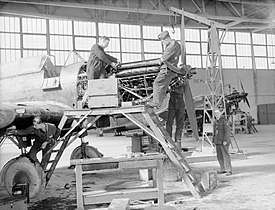 Ground crews of 226 Squadron servicing Fairey Battle engines at Reims, 1939–1940. C1126
Ground crews of 226 Squadron servicing Fairey Battle engines at Reims, 1939–1940. C1126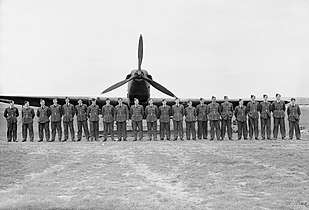 Officers of No. 103 Squadron RAF lined up at Betheniville.[lower-alpha 7]
Officers of No. 103 Squadron RAF lined up at Betheniville.[lower-alpha 7]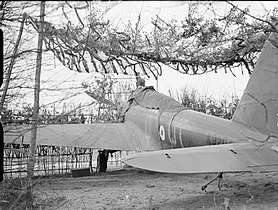 Fairey Battle, K9204 'QT-Q', of No. 142 Squadron in a camouflaged 'hide', Berry-au-Bac.
Fairey Battle, K9204 'QT-Q', of No. 142 Squadron in a camouflaged 'hide', Berry-au-Bac.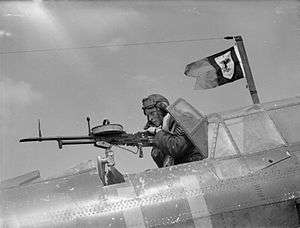 A sergeant air-gunner demonstrates a Vickers K gas-operated machine-gun.[lower-alpha 8]
A sergeant air-gunner demonstrates a Vickers K gas-operated machine-gun.[lower-alpha 8] Blenheim Mk I in flight
Blenheim Mk I in flight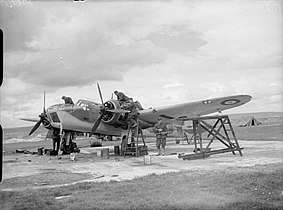 Ground crew works on a 139 Squadron Blenheim Mk IV at Plivot, 1939–1940 C1348
Ground crew works on a 139 Squadron Blenheim Mk IV at Plivot, 1939–1940 C1348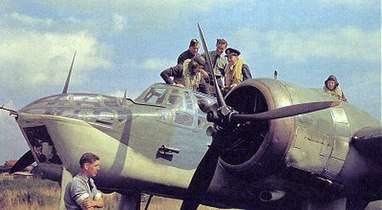 Wartime colour photograph of a Blenheim Mk IV with crew and ground crew.
Wartime colour photograph of a Blenheim Mk IV with crew and ground crew.
Notes
- ↑ K9325 (rear) shot down at St Vith, crew captured, K9324 (centre) survived campaign, K9353 (near) shot down over Luxembourg, 12 May, crew killed.[9]
- ↑ Detached from the Air Component.[18]
- ↑ The England-based squadrons were to have been the 2nd echelon of the AASF.[19]
- ↑ BAFF HQ was at Coulommiers, thence to Château Reze, Pornic on 16 June; AASF HQ was based at Château Polignac, Reims then moved to Troyes on 15 May, Muides near Blois on 3 June and Nantes on 10 June. The Air Component HQ was based at Maroeuil, moved to Arras 9 May, Hazebrouck 16 May and returned to England 21/22 May.[22]
- ↑ Drivers were rushed by air from Britain and were ignorant of the vehicles, the locations of AASF bases and of France; someone loaded the starting handles, jacks and tools onto a lorry for the west coast, under the impression that they were superfluous spare parts.[47]
- ↑ The squadron commander managed to prevent the disbandment of the squadron and obtained enough crews and aircraft to take six aircraft on a night raid within 48 hours.[50]
- ↑ Left to right: Squadron Leader H G Lee (wounded, 9 June), Pilot Officer V Cunningham (killed, 14 May), Flying Officer J R Hayes, Flying Officer G B Morgan-Dean (killed, 12 May), Flying Officer D D A Kelly, Flying Officer T B Fitzgerald, Pilot Officer T Pugh, Flight Lieutenant J A Ingram (commander, 'A' Flight), Pilot Officer Taylor (Equipment Officer), Wing Commander T C Dickens (Commanding Officer), Flight Lieutenant C E R Tait (commander, 'B' Flight), Flying Officer "Doc" Mahon (Medical Officer), Flying Officer A L Vipan, Flying Officer W Rayne, Flying Officer Rhys Price (Officer i/c Servicing Flight), Flying Officer M C Wells (prisoner of war, 10 May), Flying Officer MacDonald (Intelligence Officer), Flying Officer J N Leyden (prisoner of war, 26 May), Pilot Officer E E Morton (killed, 12 May), Pilot Officer K J Drabble (killed, 10 May), Flight Lieutenant Fallowfield (Intelligence Officer) and Pilot Officer J C F Hayter.
- ↑ 103 Squadron at St-Lucien Ferme near Rheges. Note the unofficial flight and squadron pennant flying from the radio mast.
Footnotes
- 1 2 Ellis 2004, pp. 25–26.
- ↑ Webster & Frankland 2006, p. 92.
- ↑ Richards 1974, p. 32.
- ↑ Ellis 2004, p. 3.
- ↑ Richards 1974, pp. 34, 37.
- ↑ Jackson 1974, p. 17.
- ↑ Jackson 1974, pp. 17, 24.
- ↑ Jackson 1974, pp. 24–25, 27, 29.
- ↑ Thorburn 2013, p. 39.
- ↑ Richards 2001, pp. 43–44.
- 1 2 Richards 1974, p. 109.
- ↑ Terraine 1998, p. 123.
- 1 2 Richards 2001, p. 43.
- ↑ Jackson 1974, p. 34.
- 1 2 Cull 1999, p. 1.
- ↑ Jackson 1974, pp. 31–34.
- ↑ Jackson 1974, pp. 31, 136.
- ↑ Cull 1999, p. 2.
- ↑ Jackson 1974, p. 136.
- ↑ Richards 2001, p. 52.
- 1 2 Ellis 2004, p. 27.
- ↑ Cornwell 2007, pp. 178–179.
- ↑ Ellis 2004, pp. 27–28.
- ↑ Buckley 2001, p. 122.
- ↑ Ellis 2004, pp. 24, 27–28, 19.
- ↑ Jackson 1974, pp. 34–36.
- ↑ Jackson 1974, pp. 36–39.
- ↑ Jackson 2001, p. 98.
- ↑ Richards 1974, pp. 119, 109.
- ↑ PRO 2001, pp. 66, 69.
- ↑ Jackson 2001, p. 99.
- 1 2 Richards 1974, p. 113.
- ↑ Jackson 1974, p. 77.
- 1 2 Jackson 2001, pp. 99–102.
- ↑ Jackson 2001, p. 102.
- ↑ Jackson 2001, p. 103.
- ↑ Jackson 2001, pp. 103, 102.
- 1 2 Jackson 2001, pp. 103−104.
- ↑ Jackson 2001, pp. 104−106.
- ↑ Jackson 2001, pp. 104−107.
- ↑ & Richards 1974, p. 119.
- ↑ Jackson 2001, p. 107.
- 1 2 Jackson 2001, p. 108.
- ↑ Jackson 2001, pp. 110–111.
- ↑ Jackson 2001, pp. 112, 113–114.
- ↑ Jackson 1974, p. 58.
- 1 2 Richards 1974, p. 125.
- ↑ Richards 1974, pp. 125–126.
- 1 2 Jackson 1974, pp. 58–59.
- ↑ Richards 1974, p. 129.
- ↑ Richards 1974, pp. 126–127.
- ↑ Jackson 2001, p. 137.
- ↑ Jackson 1974, p. 59.
References
Books
- Buckley, J. (2001). "The Air War in France". In Bond, B.; Taylor, M. D. The Battle for France & Flanders Sixty Years On (1st ed.). Barnsley: Leo Cooper. pp. 111–128. ISBN 978-0-85052-811-4.
- Butler, J. R. M. (1971) [1957]. Grand Strategy: September 1939 – June 1941. History of the Second World War United Kingdom Military Series. II (2nd ed.). HMSO. ISBN 978-0-11-630095-9.
- Cornwell, P. D. (2007). Ramsay, W. G., ed. The Battle of France Then and Now: Six Nations Locked in Aerial Combat, September 1939 to June 1940. Old Harlow: Battle of Britain International. ISBN 978-1-870067-65-2.
- Cull, B.; et al. (1999) [1995]. Twelve Days: The Air Battle for Northern France and the Low Countries, 10–21 May 1940, As Seen Through the Eyes of the Fighter Pilots Involved (pbk. repr. ed.). London: Grub Street. ISBN 978-1-902304-12-0.
- Ellis, Major L. F. (2004) [1st. pub. HMSO 1953]. Butler, J. R. M., ed. The War in France and Flanders 1939–1940. History of the Second World War United Kingdom Military Series. Naval & Military Press. ISBN 978-1-84574-056-6. Retrieved 5 October 2018.
- Jackson, R. (1974). Air War over France 1939–40 (1st ed.). London: Ian Allen. ISBN 978-0-7110-0510-5.
- Jackson, R. (2001) [1972]. Before the Storm: The Story of Bomber Command 1939–42 (Cassell Military Paperbacks, London ed.). London: Arthur Barker. ISBN 978-0-304-35976-9.
- Richards, Denis (1974) [1953]. Royal Air Force 1939–1945: The Fight At Odds. I. London: HMSO. ISBN 978-0-11-771592-9. Retrieved 5 October 2018.
- Richards, D. (2001) [1995]. RAF Bomber Command in the Second World War: The Hardest Victory (pbk. Classic Penguin, London ed.). New York: W. W. Norton. ISBN 978-0-14-139096-3.
- Terraine, J. (1998) [1985]. The Right of the Line: The Royal Air Force in the European War 1939–1945 (Wordsworth ed.). London: Hodder and Stoughton. ISBN 978-1-85326-683-6.
- Thorburn, G. (2013). Bomber Command 1939–1940: The War Before the War. Barnsley: Pen & Sword. ISBN 978-1-47383-097-4.
- The Rise and Fall of the German Air Force (Public Record Office War Histories ed.). Richmond, Surrey: Air Ministry. 2001 [1948]. ISBN 978-1-903365-30-4. Air 41/10.
- Webster, C.; Frankland, N. (2006) [1961]. The Strategic Air Offensive against Germany 1929–1945: Preparation. History of the Second World War, United Kingdom Military Series. I (pbk. repr. Naval & Military Press, Uckfield ed.). London: HMSO. ISBN 978-1-84574-347-5.
Theses
- Powell, M. L. (2014). Army Co-operation Command and Tactical Air Power Development in Britain 1940–43: The Role of Army Co-operation Command in Army Air Support (PhD thesis). Birmingham University. pp. 71–103. OCLC 890146868. Docket uk.bl.ethos.607269. Retrieved 5 October 2018.
Further reading
- Ellis, Major L. F. (2004) [1st. pub. HMSO 1953]. Butler, J. R. M., ed. The War in France and Flanders 1939–1940. History of the Second World War United Kingdom Military Series. Naval & Military Press. ISBN 978-1-84574-056-6. Retrieved 27 June 2018.
- Webster, C.; Frankland, N. (2006) [1961]. The Strategic Air Offensive against Germany 1929–1945: Preparation. History of the Second World War, United Kingdom Military Series. I (pbk. repr. Naval & Military Press, Uckfield ed.). London: HMSO. ISBN 978-1-84574-347-5.
External links
| Wikimedia Commons has media related to RAF Advanced Air Striking Force. |
